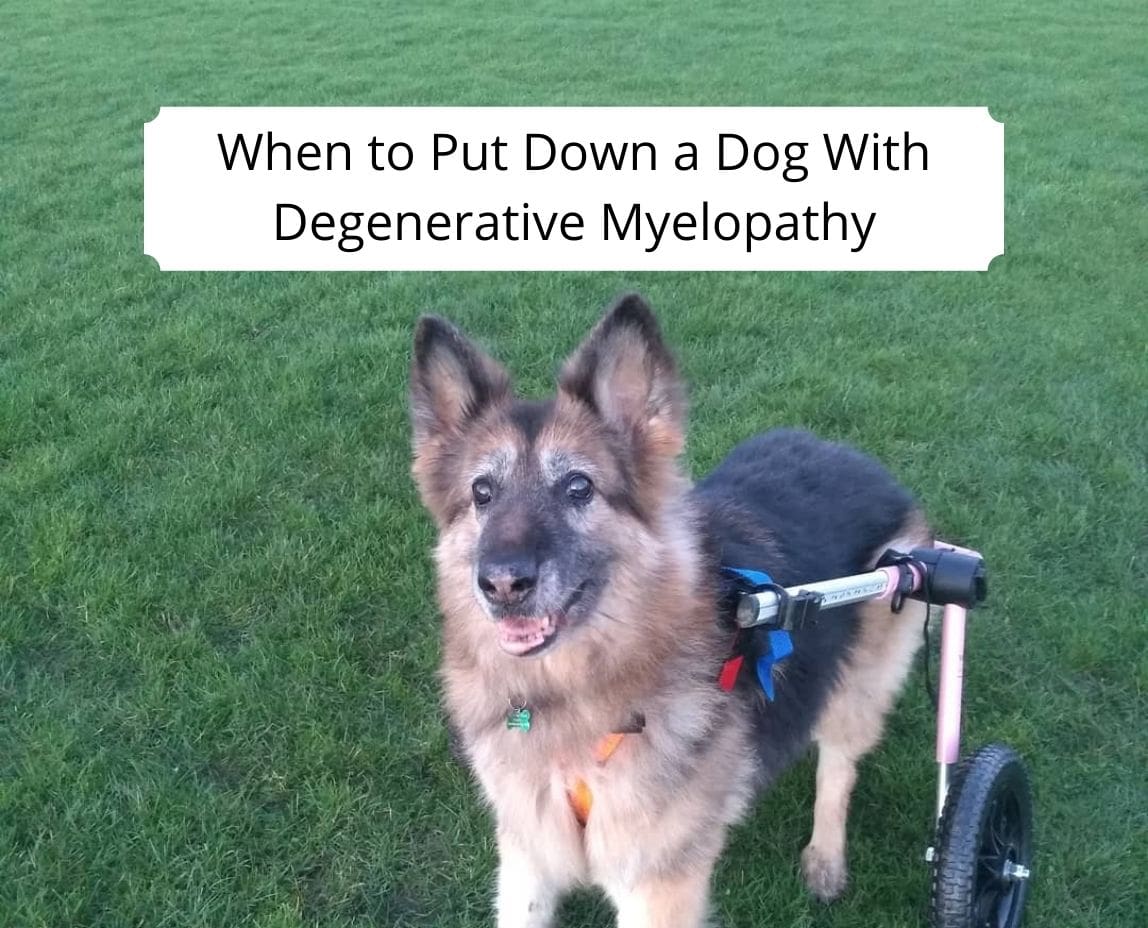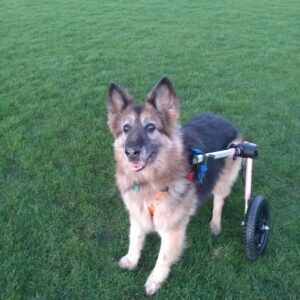Any dog diagnosed with degenerative myelopathy has to be put down or euthanized at some point. But when do you do it?
The exact time to euthanize a dog with canine degenerative myelopathy depends on several factors. After diagnosis, the vet has to determine the disease’s stage and how it impacts the dog’s quality of life. Based on the results, your vet will inform you of the most suitable period to put your furry friend down.
As a general rule, a dog suffering from degenerative myelopathy will be put down within six months to three years after diagnosis. Here is what you should know about when to put down a dog with degenerative myelopathy.
Other articles you would like: Where Can I Euthanize a Dog for Free or Cheap?
Understanding Degenerative Myelopathy in Dogs
Degenerative myelopathy (DM) is a chronic condition that affects a dog’s spinal cord. This disease will progress slowly to the dog’s hind limbs, weakening them until they become paralyzed.
According to the Orthopedic Foundation for Animals, DM primarily affects adult dogs aged 8 to 12 years, regardless of gender.
Causes
Scientists still haven’t pinpointed the exact cause of degenerative myelopathy. However, they believe the disease is a genetic disorder. Besides genetics, there is also the age and breed of your dog.
The Age Factor
Degenerative myelopathy in dogs will not kick in until your dog is around eight or nine years old, though it’s a bit different in Boxers. Degenerative myelopathy in Boxers is common between 7 and 14 years.
At this age, most adult dogs tend to suffer from other chronic conditions such as arthritis. In this case, degenerative myelopathy is not always a suspect for most dog owners. That’s because the first signs of DM resemble those of other conditions.
The best thing to do before giving any medication to your dog is to consult your veterinarian. Before settling on degenerative myelopathy, a vet will first have to rule out other conditions in the above age groups.
The Dog’s Breed
Initially, DM was common in German Shepherds and Boxers. With time, it became evident in other breeds, such as Corgis, standard poodles, and Golden Retrievers. Even mixed-breed dogs get affected, though it’s not common in them.
About Genetics
Degenerative myelopathy in dogs may be an inherited disorder caused by mutation of the SOD1 gene. For this reason, it’s a good practice to always ask about a dog’s history from the breeder before adopting them.
You should dwell more on the parents’ medical history while at it. If any of their parents suffer from this disease, there’s a good chance your pup will also contract it.
Symptoms of Canine Degenerative Myelopathy in Dogs
Early degenerative myelopathy symptoms may not be noticeable. But with time, as the disease progresses, its symptoms become evident.
Common signs include:
- Hind limbs weaken progressively
- A dog finding it hard to rise
- You’ll notice the swaying in the hind end when the dog is standing
- There will be knuckling on the dog’s paws when trying to walk
- Difficulty getting up from a sitting or sleeping position
- The dog easily falls when walking
- Paralyzed hind limbs
- The dog’s toenails become worn out
- Wobbling
- You realize that its feet are scratching the ground while walking
- You don’t notice frequent tail movements like before
The signs will present themselves in different degenerative myelopathy stages, becoming more evident in the mid and later stages.
Degenerative Myelopathy Stages
There are three different degenerative stages, early, mid, and late stages. Most symptoms emerge in the mid-stages and worsen in the late stages.
Early Stages of Degenerative Myelopathy
The first signs of degenerative myelopathy mimic other chronic diseases common in dogs. For this reason, it’s always hard to determine this disease in the early stages.
That said, your dog may experience weakness in its rear legs, uneven wear in the dog’s toenails, falling easily, and difficulties when getting up.
Mid Stage of Degenerative Myelopathy
The symptoms become more severe and too painful to watch at this stage. A dog with degenerative myelopathy in the mid-stage will show the below signs.
- Muscular atrophy
- Being completely unable to rise on its own
- Incontinence in bowel and urinary
- Inability to walk without support
- Crossing hinds
- Knuckling
- Less active tail movements
- The dog will struggle to support its weight
- Loss of coordination
Late Stages of Degenerative Myelopathy
In the degenerative myelopathy late stage, symptoms become quite severe. It’s in this stage that your dog will have more bad days than good ones. You’ll find it hard to watch your friend suffer this much, and the thoughts about euthanizing will begin to kick in.
Usually, the disease progresses quickly in dogs, more so towards its last stage. That’s the reason you may think that the late-stage signs have appeared suddenly. The truth is that the signs have been there all along, only that you didn’t notice them.
A dog in the late stages of DM may display the following signs.
- Early and mid-stage signs become severe
- A complete paralysis on the dog’s entire body
- Incontinence in bowel and urinary
- The dog’s rear legs can’t bear any weight
- Your dog becoming completely unable to stand on its own such that you must provide a support system
- Anxiety and depression
- Pneumonia
- Constipation
- Difficulty breathing/ panting
- Excessive vomiting or diarrhea
- Bleeding profusely
- Organ failure
Degenerative Myelopathy Treatment
Before treatment, your dog has to be diagnosed with this disease. Diagnosis is a long process since the vet must conduct several tests to rule out other conditions. There will be X-rays, cerebrospinal fluid tests, neuromuscular tests, and tissue biopsies.
Before settling on this disease, your vet will also check on the dog’s medical history and may even conduct a genetic test. Once diagnosed, you and your vet can now look at the possible treatment options.
Although there hasn’t been an approved degenerative myelopathy treatment, there are still ways you can help your dog. Most treatment options focus on lessening pain and improving your dog’s life quality.
A dog suffering from this condition needs to be physically active, so anything that can keep your dog up and about can be of great help. Exercise, for instance, prolongs the dog’s mobility and muscle mass. Other effective treatment options include:
- Physical therapy or veterinary rehabilitation may help restore your dog’s mobility and quality of life.
- Feed your dog healthy meals. Wholesome meals packed with vital nutrients, carbohydrates, and proteins are necessary.
- Consider buying a dog harness to help with your dog’s mobility.
- Provide the necessary nursing care required to prevent other complications in your dog. Don’t allow other infections like urinary tract infections and decubitus ulcers to affect your furry friend.
- If possible, buy a cart or wheelchair to help improve your dog’s quality of life and mobility.
- Water aerobics can also provide the needed exercise.
These options will not only keep your loyal friend healthy but also make them happy and comfortable. Vets believe that a diet rich in vitamins B, C, and E, medications, and exercise can help slow the progression of early-stage symptoms.
However, if you notice that the dog doesn’t seem happy even after providing these treatment options, consider the possibility of euthanizing. Don’t prolong your dog’s pain and suffering any longer.
How Fast Does Degenerative Myelopathy Progress in Dogs?
Knowing how fast this disease progresses in dogs will help you understand the right time to put your furry friend down. You’ve probably read this before, but it’s still worth repeating.
Unfortunately, degenerative myelopathy tends to progress so quickly in dogs. You’ll painfully watch your dog become weaker and weaker every day until the dog, and even you, can’t take it anymore.
Your dog may develop paraplegia within 6-12 months after diagnosis. That’s how fast degenerative myelopathy progresses in dogs.
How Long Will Your Dog Live With Degenerative Myelopathy?
As mentioned earlier, degenerative myelopathy life expectancy for dogs is between six months to three years. Please note that this disease tends to progress fast through the three stages, early, mid, and late. This quick progression may force you to put down your dog after a year or two from diagnosis.
Your dog getting diagnosed with this disease early enough means that the dog may live longer. But you can’t count on this theory, as it depends on how fast the disease progresses and how strong your dog is to stand the discomfort.
With the above treatment options, you can help prolong the life expectancy of a dog suffering from degenerative myelopathy.
Canine Degenerative Myelopathy: When to Euthanize?
Are you thinking of when to put down a dog with degenerative myelopathy? You have to consider all the stages of this disease before you can finally put your dog down. It’s clear that the more a dog lives with this condition, the more severe the symptoms become. This progressive severity gets in the way of your dog’s ability to enjoy its life.
Though your vet will be there to advise and give their professional opinion on when you should euthanize your dog, you have the final say. No one understands your dog more than you do, and with this in mind, you can tell when the dog is not getting the most out of its life.
Several signs will warn you that your dog has reached its final stages with the disease and that you should let it rest. Degenerative myelopathy and panting are conditions that a dog shouldn’t deal with longer.
Letting a dog peacefully slip away is better than watching them suffer much longer, knowing well that eventually, they’ll go because the disease is incurable. At least, you’ll live knowing that you did the right thing at the right time.
Pug Myelopathy: When to Euthanize?
Being small, pugs have also proven to be susceptible to degenerative myelopathy. The exact process applies when euthanizing a pug with degenerative myelopathy.
It’s advisable to put your pug down six months after being diagnosed with this disease. The timeframe could be longer and is dependent on the pain and suffering of your pug.
Conclusion For When to Put Down a Dog With Degenerative Myelopathy
How severe is the disease in your dog? Is your dog still able to enjoy a quality life even with the disease? Answering these two questions will enable you to decide when to put down a dog with degenerative myelopathy.
This disease is indeed incurable, but there are things you can do to your dog to lessen the pain and improve its quality of life. Should you notice any of the listed symptoms, please visit your vet for diagnosis before it’s too late. Always remember that putting down a dog with degenerative myelopathy is better than watching your dog suffer.
Other articles you will like:
- When to put down a Diabetic Dog?
- Putting a Dog to Sleep with Benedryl
- When to Euthanize a Dog with Kidney Failure?
Dr. Chyrle Bonk received her veterinary degree from Oregon State University in 2010. She has been practicing in a mixed animal clinic in rural Idaho ever since at Clearwater Valley Veterinarian Clinic. When she’s not busy writing, treating animals, or working on her cattle ranch, she may be found somewhere in the Idaho wilderness with her husband and kids. Dr. Chyrle Bonk is a writer for We Love Doodles and verifies that the information we post is accurate the up to date! She is also an advisor and editor.
Why Trust We Love Doodles?
At We Love Doodles, we’re a team of writers, veterinarians, and puppy trainers that love dogs. Our team of qualified experts researches and provides reliable information on a wide range of dog topics. Our reviews are based on customer feedback, hands-on testing, and in-depth analysis. We are fully transparent and honest to our community of dog owners and future owners.







